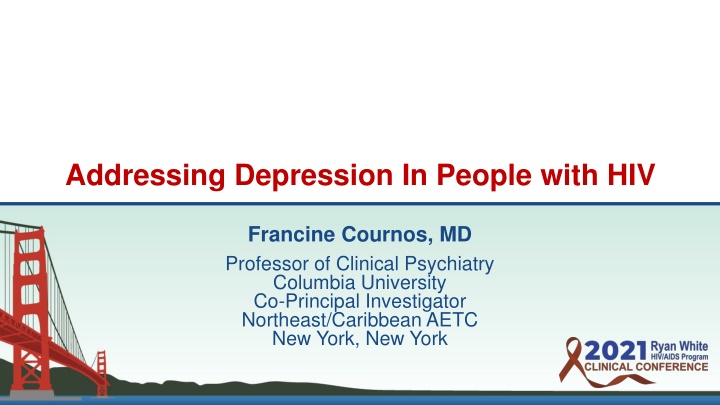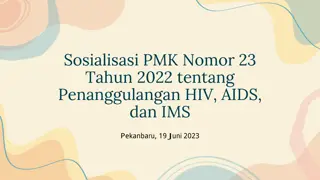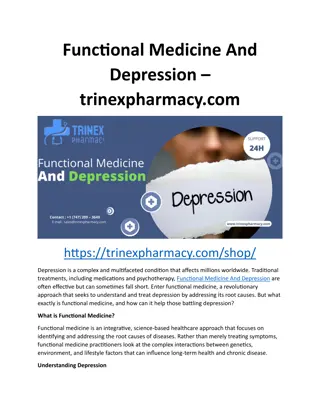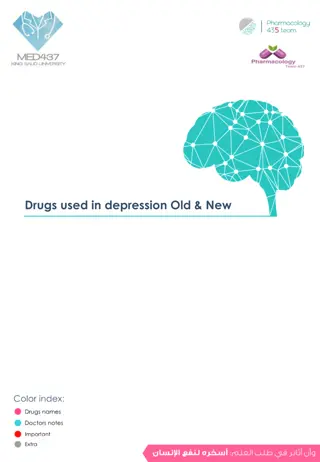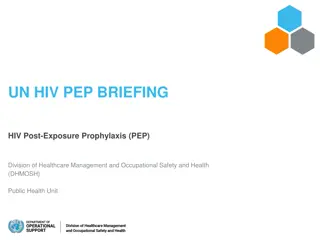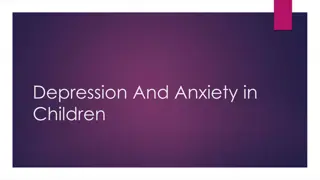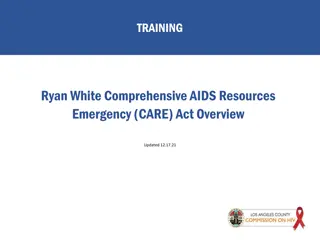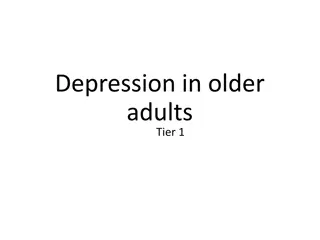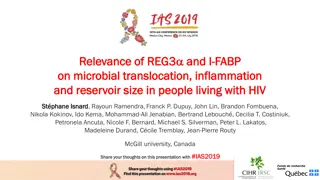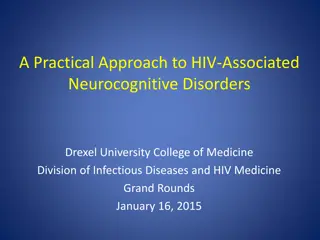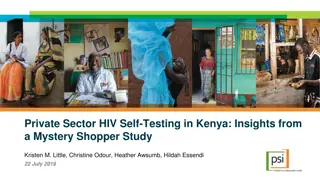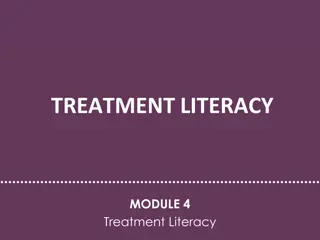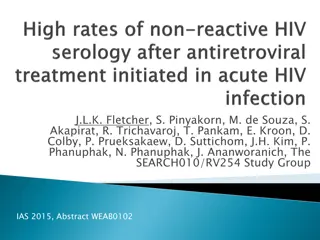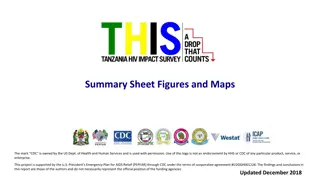Depression in People with HIV by Francine Cournos, MD
Addressing the prevalence and challenges of depressive disorders among individuals with HIV, this presentation highlights the importance of differential diagnosis, treatment strategies, and the impact on overall health outcomes.
Download Presentation

Please find below an Image/Link to download the presentation.
The content on the website is provided AS IS for your information and personal use only. It may not be sold, licensed, or shared on other websites without obtaining consent from the author.If you encounter any issues during the download, it is possible that the publisher has removed the file from their server.
You are allowed to download the files provided on this website for personal or commercial use, subject to the condition that they are used lawfully. All files are the property of their respective owners.
The content on the website is provided AS IS for your information and personal use only. It may not be sold, licensed, or shared on other websites without obtaining consent from the author.
E N D
Presentation Transcript
Addressing Depression In People with HIV Francine Cournos, MD Professor of Clinical Psychiatry Columbia University Co-Principal Investigator Northeast/Caribbean AETC New York, New York
Financial Relationships With Ineligible Companies (Formerly Described as Commercial Interests by the ACCME) Within the Last 2 Years Dr Cournos has no relevant financial relationships with ineligible companies to disclose. (Updated 3/31/21) Slide 2 of 33
Learning Objectives At the end of this presentations, learners will be able to: Describe the approach to the differential diagnosis and management of depressive illnesses among people with HIV. Differentiate the diagnosis and treatment of major depression from the diagnosis and treatment of bipolar depression. Cite the current evidence for the impact of depression treatment on both mental health outcomes and HIV outcomes among people with HIV. Slide 3 of 33
Depression Among People with HIV Worldwide, estimates of depressive disorders among people with HIV vary widely from 6-67%, depending on the population surveyed, the approach to diagnosis, etc. Research generally shows that depression in the most common psychiatric disorder seen in HIV clinical settings in the U.S., with rates hovering around 30-40%. Among people with HIV in the U.S., depressive disorders have high rates of comorbidity with other psychiatric illnesses, such alcohol/substance use disorders, anxiety disorders and PTSD. Cournos, McKinnon, Wainberg, in Comprehensive Textbook of AIDS Psychiatry: A Paradigm for Integrated Care, 2017 Slide 4 of 33
Treating Depressive Illness Contains More Uncertainty than Treating HIV Infection Treating depressive illness currently involves more trial and error than does treating HIV infection. Psychiatry has no biological tests for the diagnosis of depression (nothing equivalent to detecting HIV or its associated antibody responses) Psychiatry has no direct biological tests for the efficacy of selecting (no phenotype, genotype, resistance testing, etc; but there are tests for drug metabolism and drug levels). The idea that its simple to screen for and treat depression is not yet true The brain is the body s most unique and least understood organ (which is why psychiatry is both difficult and fascinating) Slide 5 of 33
Given the Frustrations of Treating Depressive Illness, Why Is Persevering So Important? Depressive illness is one of the most frightening and disabling of all illnesses, as described below: I did not die, and yet I lost life s breath. Imagine for yourself what I became, deprived at once of both my life and death. (Dante Alighieri, The Inferno, translated by John Ciardi. Dante was born in1265 and the DSM (1) was born in 1952, so Dante had no official DSM diagnoses. But his descriptions of depressive illness are extraordinary!) I lay down fully dressed in nice clothes, in the mud and I didn t care about standing up ever again. (Andrew Solomon, The Anatomy of Melancholy, The New Yorker) My next-door neighbor, Ms.O: Of all the illnesses I ve ever had, including surgery for cancer, none have been as painful or frightening as depression. Successfully treating depressive illness gives people their lives back. Slide 6 of 33
Depressive Symptoms vs Depressive Illness Mild depressive symptoms are ubiquitous. Depressive symptoms can occur as part of almost any serious medical illness or neurological condition. Depressive symptoms can occur as part of almost any other psychiatric diagnosis or as part of ordinary distress. Ruling out simple stress and numerous other medical and psychiatric conditions is key to settling on a psychiatric diagnosis of depressive illness. Slide 7 of 33
Differential Diagnosis of Depressive Symptoms Even though it s na ve to screen patients for depressive symptoms without understanding the broad differential diagnosis for these symptoms, doing so is a common practice. A positive screen for depressive symptoms CANNOT BY ITSELF be used to make a psychiatric diagnosis. The SARS-CoV-2 pandemic has magnified this concern as we confront elevated rates of distress in the entire U.S. population. This talk is primarily about depressive disorders as defined in the DSM-5, and not about depressive symptoms. Slide 8 of 33
Distinguish Between Mental Distress And Mental Disorders Mental Distress Mental Disorders Can occur in response to any adversity. Usually cause either persistent severe subjective distress and/or functional impairment. Meet recognized diagnostic criteria (ICD, DSM). Often does not meet criteria for a psychiatric diagnosis or require specialized mental health interventions. Call for evidenced informed mental health interventions such as medication and psychotherapy. Often responds well to supportive strategies. Slide 9 of 33
The Two Most Commonly Used Screening Tools Used to Assess for Depressive Symptoms The Patient Health Questionnaire-2 (PHQ-2): Two questions The Patient Health Questionnaire-9 (PHQ-2): Nine questions A combination of the PHQ-2 and PHQ-9 The PHQ-2 and PHQ-9 are: Quick to complete Free of charge to use and/or reproduce Well-studied Available in multiple languages The PHQ-2 and PHQ-9 can be accessed via the National HIV Curriculum and scored at that site using automatic calculators (Tools and Calculators); This site also offers extensive information about the sensitivity and specificity of these tools (Module 2, Lesson 5). Access these materials at www.aidsetc.org/nhc Slide 10 of 33
Depression As an Illness Is Found in Two Types of Psychiatric Disorders Depressive disorders, which include: Major depression Persistent depressive disorder (includes what was previously called dysthymia) Bipolar disorders (depressive phase), which include: Bipolar 1 (mania is/has been present) Bipolar 2 (hypomania is/has been present) Cyclothymia (does not meet full criteria for bipolar 1 or 2) Slide 11 of 33
Major Depression is Best Conceptualized as a Medical Co-morbidity of HIV Infection SOMATIC Appetite/Weight loss Sleep disturbance Agitation/retardation Fatigue Loss of concentration AFFECTIVE Depressed mood Loss of interest Guilt, worthlessness Hopelessness Suicidal ideation Major depression among people with HIV is associated with increased mortality and worse outcomes along the entire HIV care continuum. Slide 12 of 33
Aim to Achieve Remission of Depressive Illness, Not Just Improvement Because there s no penicillin for depression, we largely treat patients by trial and error, monitoring tolerability to side effects and degree of improvement. Response to treatment (>50% reduction of symptoms) is a much less desirable outcome than remission from depressive illness (few or no symptoms); persistent symptoms pose a risk for relapse. Our best evidence suggests the first trial of an antidepressant has a 1 in 3 chance of achieving acute remission. If the first trial at an adequate dose doesn t work, switching to a different antidepressant also has about a 1 in 3 chance of achieving acute remission. Therefore, about 2 in 3 patients will achieve acute remission with two antidepressant trials. Slide 13 of 33
Treatment of Unipolar Major Depression: Switching Antidepressants and When to Refer It is valuable for prescribers in primary/HIV care to know how to use several antidepressants and be willing to switch patients from one to another depending on patient outcomes (symptom improvement and ability to tolerate side effects). If the patient does not improve sufficiently after two adequate trials, refer to mental health specialty care. Other reasons to refer to specialty care include bipolar depression, psychotic depression, risk for suicide and/or violence, diagnostic uncertainty, and the need for brain stimulation and/or more experimental treatments. Slide 14 of 33
Distinguish Between Major Depression and Bipolar Depression Bipolar depression accounts for most of the time that people with bipolar disorder spend unwell. This may help explain why, in primary care, over 3 in 20 patients diagnosed with a depressive disorder have an unrecognized bipolar disorder. First line pharmacologic treatment of bipolar depression is mood stabilizers (lithium, anticonvulsants, atypical antipsychotics), whereas for major depression it s antidepressants. Giving antidepressants alone to people with bipolar depression works poorly and may precipitate mania. McIntyre, et al, Curr Med Res Opin, 2019; Devaney, et al, Gen Hosp Psych, 2019 Slide 15 of 33
Diagnosing Bipolar Disorder There are no brief screens for bipolar disorder. The Mood Disorders Questionnaire (MDQ) is available but has 13 items. Ask if the patient or a close relative has ever been told s/he has manic-depressive illness or bipolar disorder? Consider a few questions from the MDQ (based on the DSM-5): Has there ever been a period of time when you were not your usual self, and you had much more energy than usual? Has there ever been a period of time when you got much less sleep than usual and found you didn t really miss it? If you get yes answers to any of the above questions, you might consider completing the MDQ (www.aidsetc.org/nhc) and/or referring the patient for a diagnostic evaluation. Slide 16 of 33
Managing Bipolar Disorder On average, bipolar disorders are more severe illnesses than depressive disorders. This was one reason for the creation of two separate categories for these conditions in the DSM-5. Many people with bipolar disorder need lifetime ongoing management for this condition to maximize social/occupational functioning and well being. Evidence shows that intensive psychotherapy helps. Despite the associated disabilities, there s a long list of famous artists, fiction writers, inventors, politicians etc. with bipolar disorder. People with bipolar disorder are most amenable to treatment during the depressive phase of the illness. Those who feel euphoric and energized during (hypo)mania often reject care while in that state. Slide 17 of 33
Many Exceptional People Have Had Bipolar Disorder: Artists Slide 18 of 33
Many Exceptional People Have Had Bipolar Disorder: Politicians and Writers Winston Churchill was the Prime Minister of the UK who achieved victory during World War II. He was diagnosed with bipolar disorder in middle age and openly referred to his depression as his black dog. He wrote voluminously and won the Nobel Prize in Literature in 1953. Slide 19 of 33
Many Exceptional People Have/Had Bipolar Disorder: Dancers and Entertainers Alvin Ailey was a renowned modern dancer and choreographer whose bipolar disorder was aggravated by his drinking and drug use. He died of AIDS in 1989, but his work lives on through the Alvin Ailey American Dance Theater. Slide 20 of 33
Alcohol/substance use co-morbidity Psychiatric disorders carry a high degree of comorbidity with one another: Alcohol and other substance use disorders are common co-morbidities of depressive illnesses. We have yet to understand if there s an underlying biological vulnerability that could help explain why these diagnoses frequently travel together. Siloed services for mental illness and substance use disorders are a major barrier to good behavioral health care Most people with alcohol/substance use disorders receive no treatment for these conditions Slide 21 of 33
Alcohol/substance use co-morbidity In general, outcomes tend to be significantly worse among patients diagnosed as having both major depressive disorder and an alcohol/substance use disorder, compared with patients who have only one of these diagnoses. A review of studies among people with bipolar disorders shows a 42% prevalence of alcohol use disorders, a 20% prevalence of cannabis use disorders and a 17% prevalence of other illicit drug use disorders. Iqbal et al, Focus (Am Psychiatr Publ). Spring 2019;Hunt, et al, J Affect Disord, 2016 Slide 22 of 33
Alcohol/substance use co-morbidity Alcohol and substance use disorders tend to be one of the most problematic of psychiatric comorbidities among people with depressive illness and HIV because of their added negative impact on morbidity, mortality, and outcomes along the HIV care continuum. In this case, two disorders = two treatments Affective disorders and alcohol/substance use disorders each require their own treatment because treating only one condition doesn t usually result in sufficient improvement of the other condition. Slide 23 of 33
The World Health Organization (WHO) Pyramid of Mental Health Services Slide 24 of 33
Activating Care along the WHO Pyramid of Mental Health Services for Depressive Illnesses Self care is essential with any chronic illness, including depressive and bipolar disorders. Depressive and bipolar disorders often occur in relapsing cycles, and self care can reduce the frequency of relapse. Informal care can address the social determinants of health (food, shelter, income support, etc.), which also reduces the risk of relapse. Specialty care can assist with stabilizing patients with depressive disorders who are being followed in HIV care. Slide 25 of 33
What Are the Hoped-for Outcomes in the Successful Treatment of Depressive Illness General outcomes Relief of suffering and improved quality of life Reduced disability and cognitive dysfunction Increased ability to function Reduced mortality due to suicide or medical illness HIV specific outcomes Improved rates of viral suppression Reduced HIV-related morbidity and mortality Slide 26 of 33
What Is the Evidence for Improved Outcomes if Depressive Illness in Treated Successfully People with HIV appear to achieve comparable outcomes with depression treatments as the general population. Evidence is mixed regarding whether successful treatment of depressive illness by itself is associated with improved rates of viral suppression; the addition of a specific adherence intervention may be needed. Evidence is not available regarding whether the successful treatment of depressive illness reverses the shortened life span of people with both chronic depression and HIV Slide 27 of 33
Workshop on Depression in People with HIV Will briefly review the evidence for response to antidepressant treatment in major depression. Will briefly review other treatments for major depression. Will briefly review interactions and overlapping toxicities between antiretroviral medications and medications used to treat depressive and bipolar disorders. Will devote most of the workshop time to discussion with participants. Slide 28 of 33
